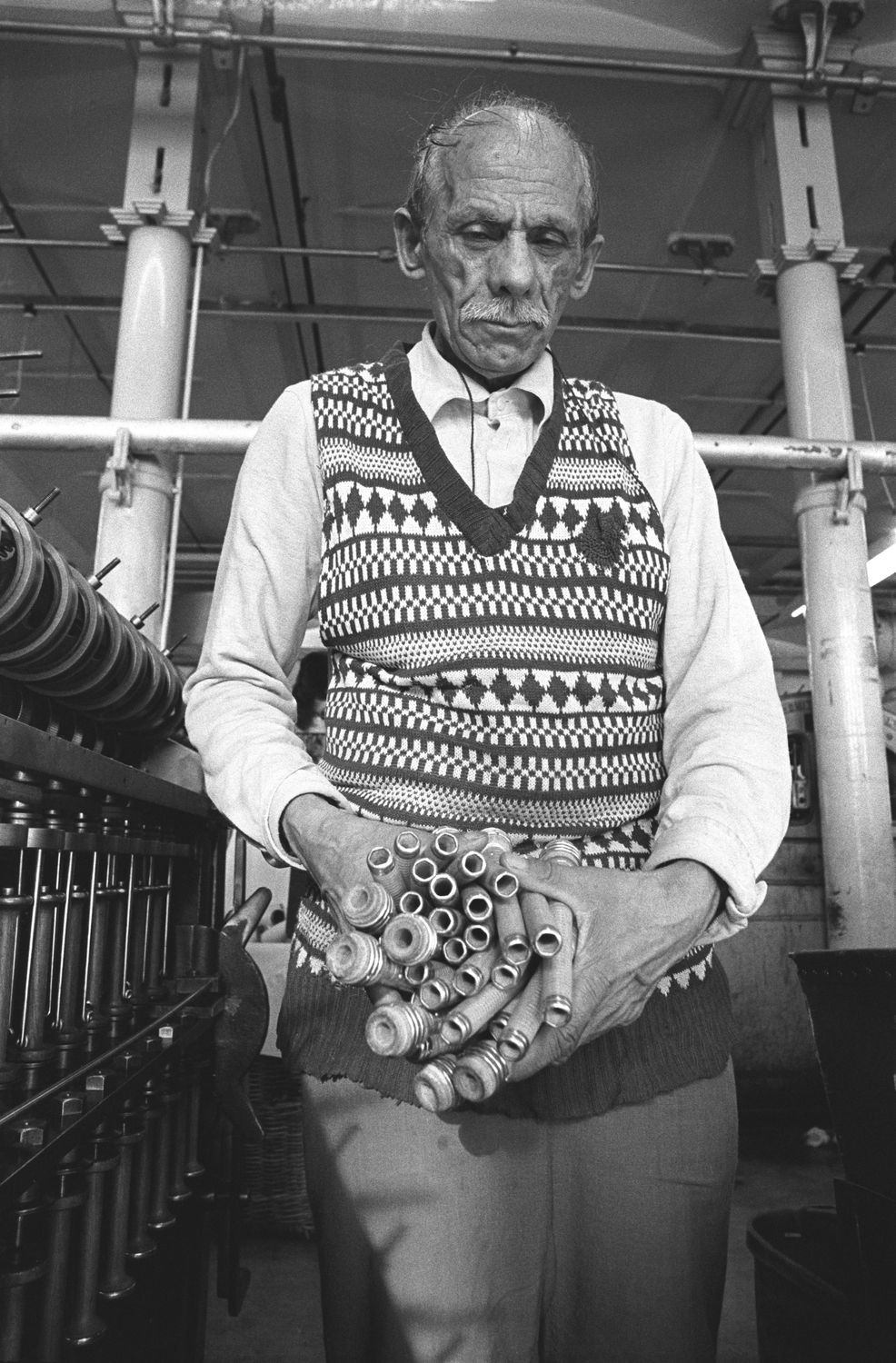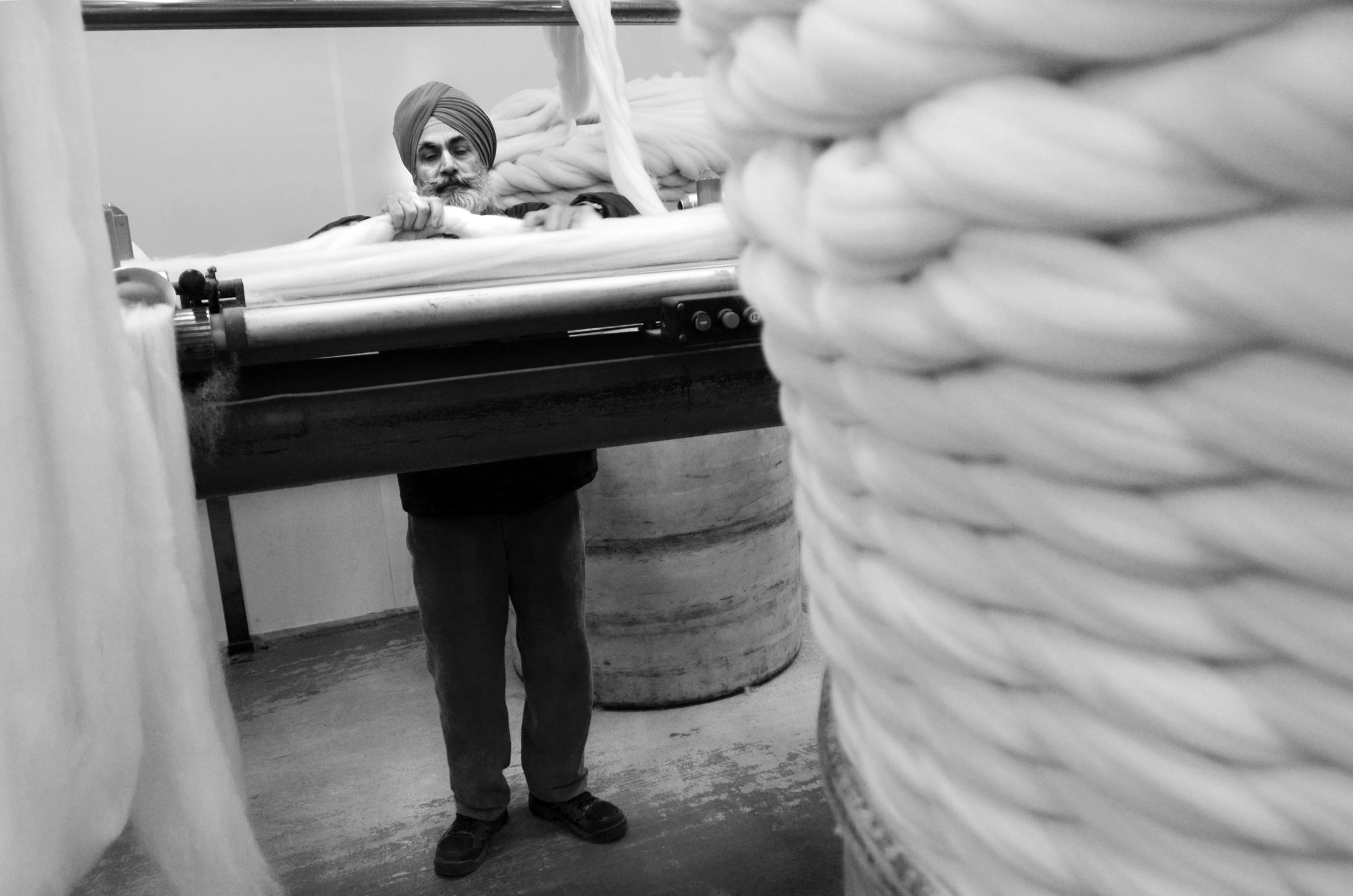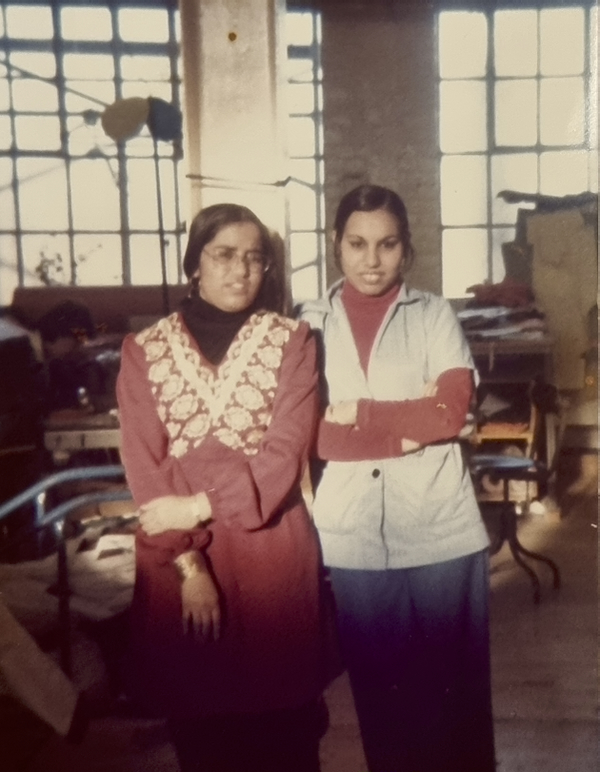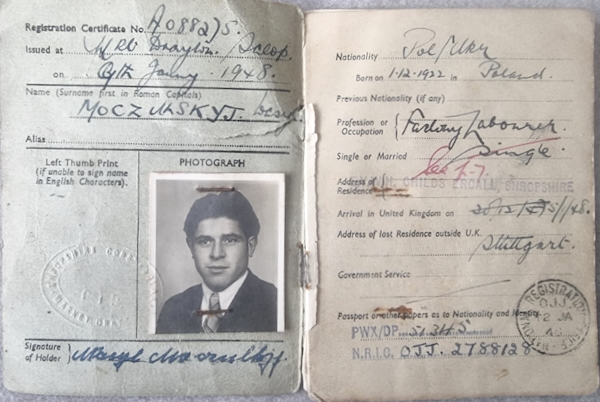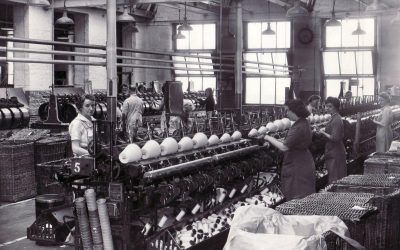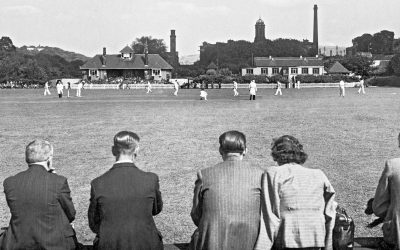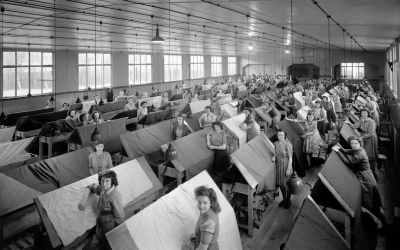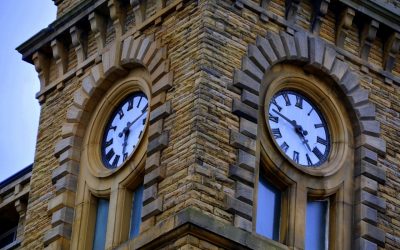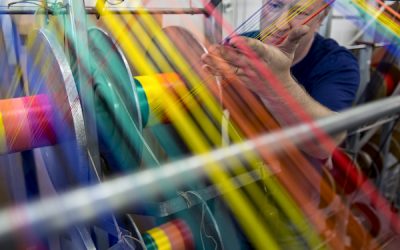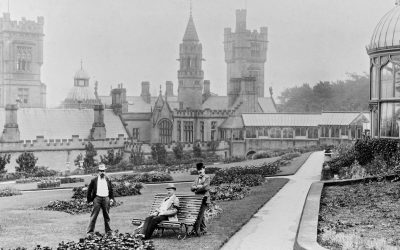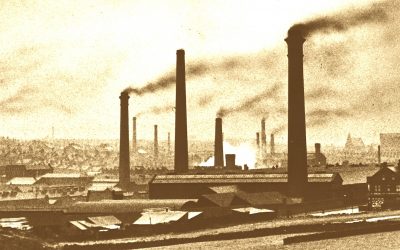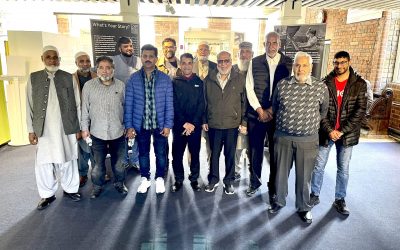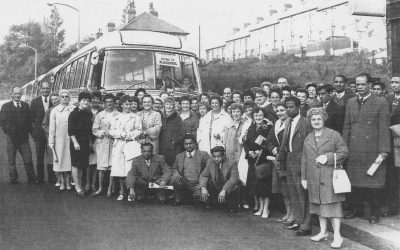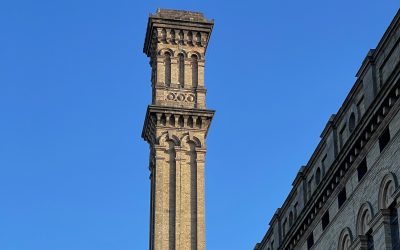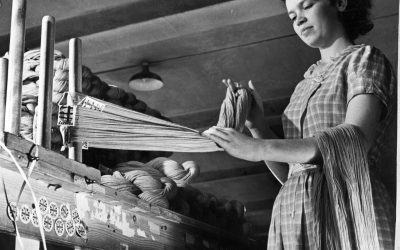The supervisors were white, whilst the machinists were Asians: Pakistani, Bengali and Indians. All very friendly. People looked out for each other and helped new ones get settled. This has changed.
Women Working at Bulmer and Lumb
Lawrence Meer | Transcript
AD: How many people worked there?
LM: 80-100 I should think, ‘cause there were guys in the warehouse as well, that moved it. The ladies, they used to run, I think, two machines each, which was four sides, what they called ‘four sides’. But they all used to help each other, because they were all on piecework. So when a doff was on – which means when the wool from the spinning was running out, and that meant that was finished, the jumbo was full – they’d shout, ‘Up, doff!’ And so two or three of them would go, and they’d all help each other get the bobbins off, and so on. It was really quite good to watch them. They were incredibly quick, these women, incredibly quick, and worked hard, blooming hard.
Age
People of all ages worked in textiles.
Between 1947 and 1972, people left school aged 15 to start full-time work. In 1972 that changed to age 16. Some young people left school one week and started work in mills the following Monday. Mills also offered apprenticeships covering the many technical skills, including engineering to keep the machinery in good working order.
In the period our interviews refer to, people tended to retire when they could receive the state pension (age 60 for women and 65 for men). Some people would choose to work longer and sometimes changed jobs within the mill to manage that.
Working for the Family Business, Bradford Waste Pulling Company (Waste Merchants)
Roger Davy | Transcript
When I got more seniority (my father eventually was persuaded to retire at 76 – only because he lost some fingers in the machine – that was the only reason he went), I never asked anyone to do a job I hadn’t done myself. And that was a great advantage. And I think it generated some respect, really. The thing I would do every morning, from almost the beginning, I would go around saying ‘Good morning’ to everybody. We were a family business, you know. And the chaps and the ladies who worked for us, they all lived within half a mile or a mile of the mill, in Dudley Hill. And they were good and faithful people. And cheerful.
AD: Did people tend to stay with you for quite a long time?
RD: 40 years, often. And fathers and sons. Fathers and sons. And we’d have… Oh, many chaps worked for 30 years or more.
Routes to Bradford
From the 1960s onwards, increasing numbers of people were moving to Britain from former colonies of the British Empire, particularly India, Pakistan and Bangladesh, and also from Caribbean countries such as Jamaica and Dominica.
These newly arrived people initially settled where work was plentiful and their labour was desperately needed, including Bradford, as textile mills offered lots of work opportunities. Most roles required no previous experience so were good opportunities to develop skills and progress. Some jobs could be done even if the worker did not speak English, although people quickly learned, especially with the help of their colleagues. However, these long shifts were often physically demanding, dirty, and unpleasant.
Migration to Bradford to work in mills has happened for two hundred years, including after World War II when huge numbers of people across Europe were not able to safely return to their homes or country of origin, and were called at the time ‘displaced persons’. Some of these people were re-settled in the UK, including in Yorkshire, and employers with staff shortages took advantage of this situation by offering jobs in textile mills. Many people from places like Ukraine, Poland, Czechoslovakia (now the Czech Republic and Slovakia) and other parts of Europe came to settle in Bradford and found work in textile mills.
In the early 1960s, some mills actively recruited young unmarried women in Italy through schemes offering passage to Bradford, accommodation in hostels and a job working in a mill. Some of these women returned to Italy after several years, at the end of the period when they were obliged to continue to work to pay off the costs of being brought to England, but others settled here, often marrying men from Bradford. Maria Tuxford’s full interview is an excellent reflection of this experience.
All sorts of people worked in Bradford’s textile mills and associated industries at the end of the 20th century. Diversity exists in many forms but here we highlight the diversity of the workforce in terms of
• Gender
• Age
• Nationality and cultural background
Gender
Men and women worked in mills at a time when some industries tended to employ more men than women. There is a long history of women working in mills but it was more actively encouraged after World War II, as there was a shortage of male workers to fill all the available jobs. At that time, mills required a lot of workers for all of the processes. Later technological advances in machinery meant fewer people were needed to operate them and reduced the size of the workforce.
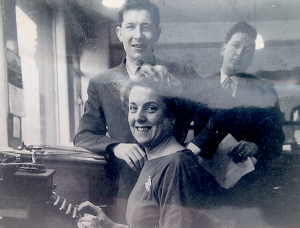
Photograph: Patricia Crabtree | Patricia’s Father, Harold Heppleston, Apprentice Accountant at Kellett Woodman
To encourage women to join the textile trade, mills made changes such as decorating working areas to make them more appealing, but more practically, ‘twilight’ shifts in the early evening for women with children. At this time, even more than now, women had full responsibility in child-rearing as well as earning an income. Some mills opened creches to provide on-site childcare.
Jobs in the mills were often spilt by gender. ‘Women’s jobs’ often involved sewing or where speed, attention to detail and fast hands were needed. Office administration, particularly work involving typing, was also considered to be work well-suited to women. Over the period, increasing numbers of women worked in textile design-related jobs and some were at the forefront of using new computing technology for design.
Wages were often lower for women than men. It was considered, at the time, that the main wage-earner in a typical household was the man and the money earned by women was an optional extra. This, of course, was not always the case.
“When I think about working at Damart, you know, there were female supervisors. But they weren’t hardly ever managers. No mill owner ever put his own daughter in the mill.”
Mohammed Hanif - Learning English in Carleton New Mill, Skipton
Mohammed Hanif | Transcript
When I left Smith Hartley and went to Aspinall Brothers, that’s where I used to work on the mule spinning. That was a bit quieter. There were carding machines on the side. And I used to work with the ladies then. I remember Miss Sheldon, she used to teach me English. She used to say something, if I don’t understand, she used to write it, tell me, ‘Take this writing home and ask somebody what it means, and tell me tomorrow.’ That’s how I learned my English! I was 15 and she was about 50-54. This different age. And when she got retired… I used to live in Keighley, and she used to live in Skipton. She changed her address. I went to see her at home because she was too old, really. And I remember her very well. And to be honest, Aspinall brothers, those people were so nice. I couldn’t think of anybody so nice. Mr. Aspinall, his son Mr. Bruce, his brother Alan, I knew them all.
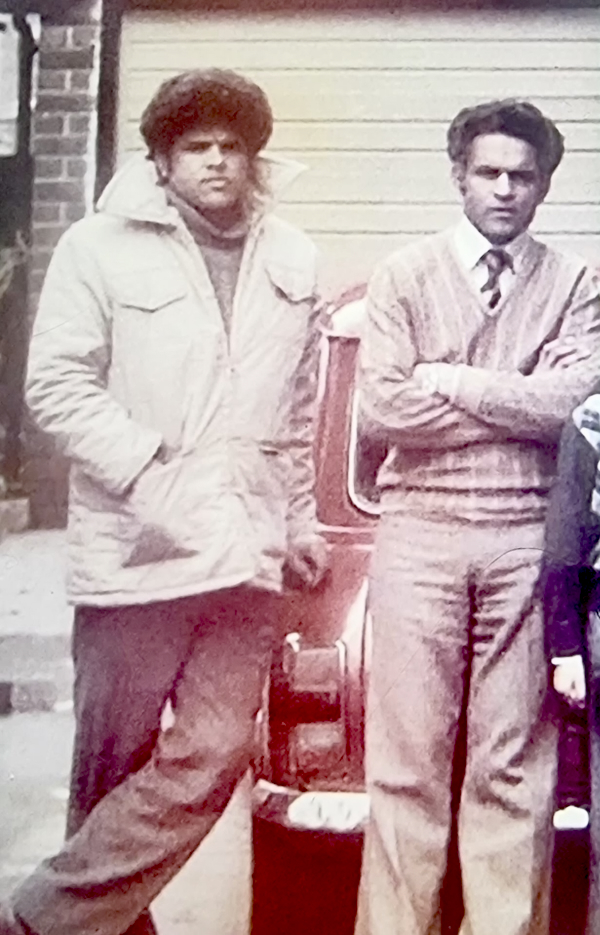
Photograph: Mohammed Ashraf
“Most of the Italian ladies that came to live in Bingley, they came to work at the mills. I think they organised coaches from Italy. They paid for all the transport and everything. I think they also found them somewhere to ‘lodge’, as my mum always called it.”
Things to do...

Bradford’s population today reflects a rich tapestry woven from migration and the textile boom. This shaped the city’s cultural landscape and as a result, most locals have ties to textile mills. To learn more, why not try the activities below:
What to do next...
Research more about how global historical events caused migration to Bradford, contributing to its famous multiculturalism.
What to do next...
Sign language was often used in mills due to the noise and varying languages spoken. With a friend, come up with your own gestures and sign language to see if you can understand each other across a busy outdoor space!
Discover More
Lost Mills
Lost Mills & Ghost Mansions
Photograph: Tim Smith | UNSPUN How To Use The Learning Zone is a rich and fascinating resource for all. Take your time to explore and discover the many stories and insights on offer. Whether you are a student, a teacher, a researcher, a community group or an...
Working life
Photograph: Tim Smith | Lifting hanks of wool from a dyeing vat at Harrison Gardner and Company. If you've seen old mills, pictures of old mills and that, you'll see that there's a big mill with five or six storeys. And then at the back of it, probably, there's a one...
Time Off
Background: Bradford Museums & Galleries | Cricket Match in Saltaire Photograph: Jaz Oldham | Party in the MillBackground: Bradford Museums & Galleries | Cricket Match in Saltaire Photograph: Patricia Crabtree | Harold Heppleston, Patricia's Father, and...
Rights & Wrongs
Photograph: Val Rowland | Anwar Hussain (L), Bill Morris, former General Secretary of the Transport and General Workers Union (C), and Muhammad Rasab (R). Representing the racial discrimination case against John Haggas Ltd onstage at the Trade Union Annual Congress...
Changing Ways
Photographs: Mark Stevenson | Dalton Mill and Clock Tower I could see at that time that the mills were starting to close around Keighley all over the town and I thought ‘I need to be moving on somewhere’ and that's when I left in 1975 and joined the fire service....
Textiles Today
Background Photograph: Tim Smith | Laxtons' state-of-the-art spinning machinery in Baildon Title Photograph: Tim Smith | Weaving of Rainbow Ribbons at Wyedean Weaving in Haworth In 2022, I saw this job. And I rang them up and said ‘I’m looking for a job as a...
Ghost Mansions
I know that Robert Clough - he had a big mansion, and he donated a Christmas tree for the people of Keighley one year. Well, I won't be swayed on this at all. Particularly on a Friday night, when everybody else had gone home,...
Research & Map
Background Photograph: Bradford Museums & Galleries | Bradford's Skyline Title Photograph: Rainbow School | Visiting Bradford's Industrial Museum I grew up next to Marriner’s and I actually watched it burn down. It would have been in the ‘70s. I was in my...
Do It Yourself
Photograph: Alan Dix | Sangat Centre at Bradford Industrial Museum I think what people should do is show an interest in local history because one day (and I hope this never happens) there won’t be people like you, and there won’t be people like me, who...
Mediawall
Photograph: Margaret Dobson via Keighley and District Local History Society | Employees of John Haggas Ltd's Outing to Blackpool Lost Mills Media Wall Here we celebrate the rich visual history shared by contributors and project partners whilst researching Bradford's...
Archive
Photograph: Alan Dix | Lister's Mill ChimneyWelcome to the Lost Mills Archive. Here you will find all the recordings and transcripts that have been made during the lifetime of the project. It contains a wealth of information - far more than we could ever use in the...
Contributors
Thank you Lost Mills and Ghost Mansions has involved at least 500 people one way or another and their support, participation and commitment has taken us on a very special journey. Most of the people we interviewed were in their 70s and 80s and some were over 90. It is...
The contents of the 509 Arts website are protected by copyright unless otherwise stated. The Lost Mills Learning Zone recordings, text and activity suggestions are free to use for non-commercial community and education purposes. If you wish to use the materials for any other purpose, email info@509arts.co.uk with your plans.
Some of the images and video footage belong to a third party and are credited as such. If you wish to use any such content, please contact 509 Arts or the copyright owner directly.

